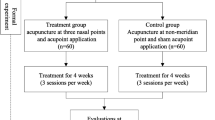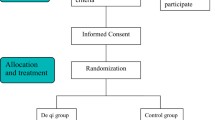Summary
Acupuncture is a therapy method known for millennia with apparently polygenetic roots. It is traditionally practiced in East Asian countries. During the recent fifty years, it has found wide applications in Europe as well. Today acupuncture is one of the most important parts of modern complementary medicine. Questions concerning the mechanism of action and efficacy of acupuncture, among others in the treatment of allergic rhinitis, still lead to many scientific discussions. This review summarizes the modern understanding of possible mechanisms of acupuncture as well as it presents the current state of clinical studies relating to the efficacy of acupuncture in the treatment of allergic rhinitis. Further investigations are necessary to confirm acupuncture as an effective therapy of allergic rhinitis.
Similar content being viewed by others
Abbreviations
- ACUSAR:
-
Acupuncture in seasonal allergic rhinitis
- IFN-γ:
-
Interferon γ
- IgE:
-
Immunoglobulin E
- IL:
-
Interleukin
- SIT:
-
Specific immunotherapy
- TCM:
-
Traditional Chinese medicine
- Th-Zellen:
-
Thelper cells
- TNF-β:
-
Tumor necrosis factor γ
References
Dorfer L, Moser M, Bahr F, Spindler K, Egarter-Vigl E, Giullén S, Dohr G, Kenner T. A medical report from the stone age? Lancet 1999; 354: 1023–5
Feucht G. Die Geschichte der Akupunktur in Europa. Heidelberg: Karl F. Haug, 1977
Melzack R, Stillwell DM, Fox EJ. Trigger points and acupuncture points for pain: correlations and implications. Pain 1977; 3: 3–23
Rhijne W. Transisalano-Daventriensis Dissertatio de Arthritide: Mantissa Schematica: De Acupunctura: Et Orationes Tres. I. De Chymiae ac Botaniae antiquitate & dignitage: II. De Psysiognomia: III. De Monstris. Singula ipsius Authoris notis illustrata. London: Impensis R. Chiswell, 1683
Nogier P. Handbook to auriculotherapy. Moulins-lès-Metz: Maisonneuve, 1968
Gleditsch JM. MAPS. MikroAkuPunktSysteme. Stuttgart: Hippokrates, 2004
Heine H. Akupunkturtherapie: Perforation der ober ächlichen Körperfaszie durch kutane Gefäß-Nerven-Bündel. Therapeutikon 1988; 4: 238–44
Kellner G. Bau und Funktion der Haut. Dt Ztschr f Akup 1966; 15: 1–32
Heine H. Anatomische Struktur der Akupunkturpunkte. Dt Ztschr f Akup 1988; 31: 26–30
Heine H. Funktionelle Morphologie der Akupunkturpunkte. Dt Ztschr f Akup 1990; 33: 69–70
Becker RO, Reichnaamis, M. Elektrophysiological correlates of acupuncture points and meridians. Psychoenergetic Systems 1976; 29: 245–56
Maresch O. Das elektrische Verhalten der Haut. Dt Ztschr f Akup 1966; 15: 33–50
Niboyet, EH. La moindre résistance à l'électricité de surfaces punctiformes et de trajets cutanés concordants avec les „points“ et „méridiens“ bases de l'acupuncture. PhD thesis, Marseille: Louis-Jean, 1963
Portnow FG. Elektropunkturnaja Refleksoterapija. Riga: Zinātne, 1987
Knardahl S, Elam M, Olausson B, Wallin BG. Sympathetic nerve activity after acupuncture in humans. Pain 1998; 75: 19–25
Sandberg M, Lundeberg T, Lindberg LG, Gerdle B. Effects of acupuncture on skin and muscle blood flow in healthy subjects. Eur J Appl Physiol 2003; 90: 114–9
Petti F, Bangrazi A, Liguori A, Reale G, Ippoliti F. Effects of acupuncture on immune response related to opioid-like peptides. J Tradit Chin Med 1998; 18: 55–63
Stux G, Stiler N, Berman B, Pommeranz B. Akupunktur, 7. Aufl. Berlin -Heidelberg - New York: Springer, 2008
Asher GN, Jonas DE, Coeytaux RR, Reilly AC, Loh YL, Motsinger-Reif AA, Winham SJ. Auriculotherapy for pain management: a systematic review and meta-analysis of randomized controlled trials. J Altern Complement Med 2010; 16: 1097–108
Molsberger A. Acupuncture in orthopedics. Orthopade 2012; 41: 100–5
Stör W, Irnich D. Acupuncture: basics, practice, and evidence. Schmerz 2009; 23: 405–17
Kim SK, Bae H. Acupuncture and immune modulation. Auton Neurosci 2010; 157: 38–41
Arranz L, Guayerbas N, Siboni L, Fuente M de la. Effect of acupuncture treatment on the immune function impairment found in anxious women. Am J Chin Med 2007; 35: 35–51
Kim CK, Choi GS, Oh SD, Han JB, Kim SK, Ahn HJ, Bae H, Min BI. Electroacupuncture up-regulates natural killer cell activity: identification of genes altering their expressions in electroacupuncture induced up-regulation of natural killer cell activity. J Neuroimmunol 2005; 168: 144–53
Lau BH, Wong DS, Slater JM. Effect of acupuncture on allergic rhinitis: clinical and laboratory evaluations. Am J Chin Med 1975; 3: 263–70
Annunziato F, Romagnani S. Heterogeneity of human effector CD4+ T cells. Arthritis Res Ther 2009; 11: 257
Romagnani S. The Th1/Th2 paradigm and allergic disorders 1998. Allergy 1998; 53(46 Suppl): 12–5
Woodfolk J. T-cell responses to allergens. Allergy Clin Immunol 2007; 119: 280–94
Woodfolk, JA. Cytokines as a therapeutic target for allergic diseases: a complex picture. Curr Pharm Des 2006; 12: 2349–63
Cutler A, Brombacher F. Cytokine therapy. Ann N Y Acad Sci 1056: 16–29
Woodfolk JA. Selective roles and dysregulation of interleukin-10 in allergic disease. Curr Allergy Asthma Rep 2006; 6: 40–6
Carneiro ER, Xavier RA, De Castro MA, Do Nascimento CM, Silveira VL. Electroacupuncture promotes a decrease in inflammatory response associated with Th1/Th2 cytokines, nitric oxide and leukotriene B4 modulation in experimental asthma. Cytokine 2010; 50: 335–40
Jeong HJ, Kim BS, Oh JG, Kim KS, Kim HM. Regulatory effect of cytokine production in asthma patients by SOOJI CHIM (Koryo Hand Acupuncture Therapy). Immunopharmacol Immunotoxicol 2002; 24: 265–74
Joos, S, Schott C, Zou H, Daniel V, Martin E. Immunodulatory effects of acupuncture in the treatment of allergic asthma. J Altern Complement 2000; 6: 519–25
Hauswald B, Schmidt Ch, Knothe J, Hüttenbrink KB, Zahnert Th. Effects of acupuncture in treatment of perennieal allergic rhinitis in comparison to antihistaminic medication. Dt Ztschr f Akup 2009; 52: 31
Petti FB, Liguori A, Ippoliti F. Study on cytokines IL-2, IL-6, IL-10 in patients of chronic allergic rhinitis treated with acupuncture. J Tradit Chin Med 2002; 22: 104–11
Rao YQ, Han NY. Therapeutic effect of acupuncture on allergic rhinitis and its effects on immunologic function. Zhongguo Zhen Jiu 2006; 26: 557–60
Christensen PA, Lauren LC, Taudorf E, Sørensen SC, Weeke B. Acupuncture and bronchial asthma. Allergy 1984; 39: 379–85
Jianli CJ. The effect of acupuncture on serum IgE level in patients with chronic urticaria. Tradit Chin Med 2006; 26: 189–90
Mösges R, Klimek L. Today's allergic rhinitis patients are different: new factors that may play a role. Allergy 2007; 62: 969–75
Bauchau V, Durham SR. Prevalence and rate of diagnosis of allergic rhinitis in Europe. Eur Respir J 2004; 24: 758–64
Cauwenberge P van, Bachert C, Passalacqua G, Bousquet J, Canonica GW, Durham SR, Fokkens WJ, Howarth PH, Lund V, Malling HJ, Mygind N, Passali D, Scadding GK, Wang DY. Consensus statement on the treatment of allergic rhinitis. European Academy of Allergology and Clinical Immunology. Allergy 2000; 55: 116–34
Schäfer T, Riehle A, Wichmann HE, Ring J. Alternative medicine in allergies - prevalence, patterns of use and costs. Allergy 2002; 57: 694–700
Brinkhaus B, Witt CM, Jena S, Liecker B, Wegscheider K, Willich SN. Acupuncture in patients with allergic rhinitis: a pragmatic randomized trial. Ann Allergy Asthma Immunol 2008; 101: 535–43
Langer H, Hauswald B. Die therapeutische Wirkung der Akupunktur und Laserpunktur bei Patienten mit Rhinopathia pollinosa. Dt Z Aku 1989; 32: 109–111
Ng DK, Chow PY, Ming SP et al. A double blind, randomized, placebo-controlled trial of acupuncture for the treatment of childhood persistent allergic rhinitis. Pediatrics 2004; 114: 1242–7
Williamson L, Yudkin P, Livingstone R, Prasad K, Fuller A, Lawrence M. Hay fever treatment in general practice: a randomised controlled trial comparing stan-dardised Western acupuncture with sham acupuncture. Acupunct Med 1996; 14: 6–10
Pfab F, Kirchner MT, Huss-Marp J, Schuster T, Schalock PC, Fuqin J, Athanasiadis GI, Behrendt H, Ring J, Darsow U, Napadow V. Acupuncture compared with oral antihistamine for type I hypersensitivity itch and skin response in adults with atopic dermatitis: a patient- and examiner-blinded, randomized, placebo-controlled, crossover trial. Allergy 2012; 67: 566–73
Lee MS, Pittler MH, Shin BC, Kim JI, Ernst E. Acupuncture for allergic rhinitis: a systematic review. Ann Allergy Asthma Immunol 2009; 102: 269–79
Roberts J. A systematic review of the clinical effectiveness of acupuncture for allergic rhinitis. BMC Complement Altern Med 2008; 8: 13
Brinkhaus B, Ortiz M, Witt CM, Roll S, Linde K, Pfab F, Niggemann B, Hummelsberger J, Treszl A, Ring J, Zuberbier T, Wegscheider K, Willich SN. Acupuncture in patients with seasonal allergic rhinitis: a randomized trial. Ann Intern Med 2013; 158: 225–34
Kim JI, Lee MS, Jung SY, Choi JY, Lee S, Ko JM, Zhao H, Zhao J, Kim AR, Shin MS, Kang KW, Jung HJ, Kim TH, Liu B, Choi SM. Acupuncture for persistent allergic rhinitis: a multi-centre, randomised, controlled trial protocol. Trials 2009; 10: 54
Kim JI, Choi JY, Lee MS, Kim TH, Kim AR, Jung SY, Shin MS, Kim KH. Acupuncture for improving chronic rhinosinusitis complicated with persistent allergic rhinitis. A prospective observational study. Forsch Komplementmed 2010; 17: 333–5
Michel W. Frühe westliche Beobachtungen zur Akupunktur und Moxibustion. Sudhoffs Archiv 1993; 77: 194–222
Author information
Authors and Affiliations
Corresponding author
Rights and permissions
About this article
Cite this article
Hauswald, B., Yarin, Y.M. Acupuncture in allergic rhinitis. Allergo J Int 23, 115–119 (2014). https://doi.org/10.1007/s40629-014-0015-3
Received:
Accepted:
Published:
Issue Date:
DOI: https://doi.org/10.1007/s40629-014-0015-3




